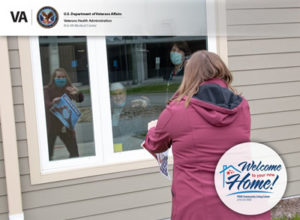
In April, the Erie, PA, VAMC, hosted a small social distancing welcome home for residents of its new 22-bed community living center. Photo from Erie VAMC Facebook page
WASHINGTON—While attention has been focused on the challenges VA faced during the first wave of the pandemic, the department has logged two notable successes compared to its civilian counterparts: Low infection rates in its community living centers (CLCs) and low infection rates among its staff.
Across the country, nursing homes have been tiny epicenters of COVID-19, with the virus spreading like wildfire among residents and staff alike. As of June, COVID-related nursing home deaths had topped 30,000 in the United States with hundreds of employees also dead from the disease. However, according to VA officials, thanks to swift action in the early days of the pandemic in addition to a greater emphasis on medical care, the department has been seeing far fewer infections at their CLCs.
At a House VA committee hearing last month examining the first 90 days of VA’s response to the pandemic, VA officials said they had found very low levels of asymptomatic positives and that the majority of VA CLCs had no positives. They noted that, in areas of the country where the overall rate was higher, there were more cases found.
“But we have entire regions of the nation where we tested all employees and all patients and found no COVID,” explained Larry Mole, PharmD, VA’s executive director for the Office of Public Health.
Asked how VA achieved that kind of success while civilian nursing homes and state veterans’ homes struggled, Mole said that it was due to several conditions specific to how VA runs its CLCs.
“We treat our CLCs like an acute care medical unit,” Mole explained. “In a civilian nursing home, usually there’s one physician who’s a medical director and some consultants who come in. In every wing of a CLC, we have assigned physicians, preferably geriatricians with expertise in elderly care or geriatric care. In addition we staff with large numbers of RNs. And we train in infection control on a monthly basis as we work our way through care.”
“Also, we aggressively manage comorbidities in veterans who are hospitalized in our CLCs,” he added.
A report from the national Centers for Disease Control and Prevention has advised that patients with comorbid conditions such as heart disease and uncontrolled diabetes were six times as likely to be hospitalized if infected with COVID-19 and 12 times more likely to die.
Because of VA’s aggressive comorbidity management, patients with diabetes and hypertension—two exacerbating factors in COVID-19—generally have those conditions under better control than in civilian nursing homes.
CLCs were also one of the first areas of VA to undergo total lockdown early on in the pandemic, with all visitors being barred early in March. This came before many states had implemented social distancing protocols.
Throughout the pandemic, VA has acted as a consultant to civilian and state homes, providing what guidance they could to help prevent the spread.
“Early on when we began to recognize that there was a difference in the outcome and the prevalence of the disease in VA CLCs versus private nursing homes around the nation we began looking at how we might do a level and staged approach to support,” explained Richard Stone, MD, VHA’s executive-in-charge. “There are hundreds of VA employees that are out providing consultative services.”
That consultation includes lessons on how to properly use PPE, how to establish a COVID-positive zone and a standard zone within a facility that might have connecting corridors between those zones, and how to prevent personnel from crossing over and inadvertently contaminating the standard zone.
Continue Reading this Article: Consultant Services


